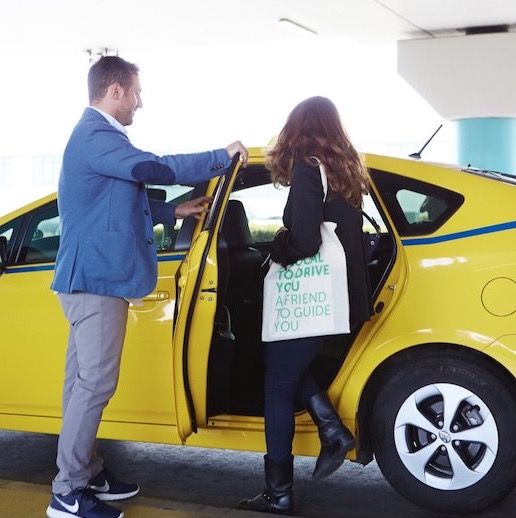Istanbul Taxis
As you navigate the bustling streets of Istanbul, the city’s iconic yellow taxis are impossible to miss. These taxis have been an integral part of Istanbul’s transportation network for decades, efficiently shuttling both locals and visitors across the sprawling metropolis. Stepping into one of Istanbul’s taxis offers a glimpse into the daily lives of the city’s residents and a chance to connect, however briefly, with the taxi drivers themselves. Though Istanbul continues to modernize at a rapid pace, its taxi fleet provides an enduring link to the city’s storied past. For a truly authentic experience in Istanbul, hail one of the yellow taxis and strike up a conversation—you never know where it might lead.
A Brief History of Istanbul’s Famed Yellow Taxis
Since 1911, Istanbul’s iconic yellow taxis have transported both Turks and tourists around the bustling metropolis. The city’s first taxis were horse-drawn carriages, followed by Ford Model T’s in the 1920s. Istanbul’s taxi fleet grew rapidly over the
following decades. In the 1960s and 70s, many yellow taxis were the Fiat 131, Dodge Dart, and Camaro models. Mercedes W123’s and Peugeot 505’s were popular in the 1980s, while in the 1990s, new taxi designs and liveries were introduced.
The current yellow taxis are predominantly Volkswagen Transporter vans. Some taxi companies have more luxurious Mercedes Vito or Viano minivans for tourists and business travelers. Despite competition from private hire cars and rideshares, Istanbul’s licensed yellow taxis remain an essential part of the city’s transportation network. Over 18,000 yellow taxis serve 300 million passengers annually.
Fares are government-regulated, with extra charges for luggage, nighttime driving, bridges, and highway use. Most taxi drivers do not speak English, so it is best to have your destination address written down or provide a map. Taxis can be hailed on the street or found at taxi stands outside hotels, attractions, and transport hubs.
Istanbul’s yellow taxis have witnessed the city’s growth over a century and remain an integral part of its history and culture. Climbing into one of these famed cabs is a quintessential Istanbul experience.
What Makes Istanbul’s Taxi System Unique
Istanbul’s taxis are an integral part of the city’s transportation infrastructure, with a rich history and unique characteristics that set them apart.
A Vast Network
Istanbul has over 17,000 taxis servicing a population of over 15 million people. This extensive network of taxis provides an essential mode of transit for both tourists and residents navigating the city. Taxis are readily available 24 hours a day, even during off-peak hours, with designated taxi stands located throughout the city for easy access.
Distinctive Yellow Cabs
Istanbul’s taxis are instantly recognizable by their yellow color and “TAKSİ” sign on top. These yellow cabs have become an iconic symbol of Istanbul and provide a convenient way for visitors to get around the city. The taxis are mostly diesel-powered sedans that can seat up to five passengers. Some taxis now offer additional amenities like Wi-Fi, phone chargers, and cashless payment options.
Set Fares
Unlike taxis in many other major cities, Istanbul operates on a system of set fares based primarily on distance. The initial fare covers the first 2 kilometers, with additional charges for longer rides. The fare rates are standardized and strictly regulated. While the taxis may not always be the most budget-friendly option, the set fares at least provide price predictability for riders. The fares are clearly displayed inside each taxi so passengers know the expected cost of their trip before departing.
Skilled Drivers
Istanbul’s taxi drivers undergo extensive training to navigate the city’s busy and complex roads. The drivers are very familiar with the area and adept at handling Istanbul’s heavy traffic. They are also generally courteous and helpful, especially for foreign visitors unfamiliar with the city. While some drivers’ English language skills may be limited, many go out of their way to ensure passengers reach their desired destinations.
Experiencing the City via Taxi: Key Sights and Neighborhoods
Experiencing Istanbul via taxi offers a glimpse into the vibrant fabric of the city. As you travel between neighborhoods, pay attention to the sights along the way to gain insight into daily life in this cultural melting pot.
Beyoglu
Once in Europe’s entertainment center, Beyoglu explodes with activity day and night. Walk Istiklal Avenue, lined with shops, restaurants, and nightclubs, where musicians and vendors fill the streets. Visit Galata Tower, a medieval stone tower providing panoramic views of the city. Wander the backstreets to find historic churches like St. Anthony of Padua.
Sultanahmet
The historic heart of Istanbul overflows with architectural and cultural landmarks. Admire the domes and minarets of Hagia Sophia and the Blue Mosque, two of the world’s greatest religious structures. Explore Topkapi Palace, the opulent residence of Ottoman sultans for 400 years. Spend hours uncovering treasures in the Grand Bazaar, one of the oldest and largest covered markets on the planet.
Bosphorus
The Bosphorus Strait separates Europe and Asia, with Istanbul straddling both continents. Mansions, palaces and waterside villas line the strait, now occupied by some of the city’s most affluent residents. Hop on a ferry to cruise the Bosphorus, passing under bridges that connect Europe and Asia. Disembark at picturesque villages like Bebek to dine along the shore.
Outside the Center
Venture beyond the usual tourist sights to discover Istanbul’s diverse neighborhoods. Head to Kadikoy and Moda on the Asian side, with a more bohemian vibe and fewer crowds. Explore the hilly, historic Eyup district, home to the Eyup Sultan Mosque. In Sariyer, wander along the shores of the Black Sea at Rumeli Feneri, a popular weekend escape. Journeys by taxi reveal the true spirit of this unparalleled metropolis.
Taxi Etiquette and Tips for Tourists
When taking taxis in Istanbul, follow these etiquette tips to ensure a smooth experience:
Communicate Your Destination Clearly
Tell the driver your destination address and point it out on a map to avoid any confusion. Many taxi drivers in Istanbul do not speak English fluently, so speaking slowly and clearly about where you need to go is important. Have your hotel or location address written down to show the driver.
Agree on a Price Upfront
Unlike many cities where taxis operate on a meter system, Istanbul taxi fares are often negotiated upfront. Ask the driver for an estimated fare to your destination before getting in the taxi to avoid being overcharged at the end of your ride. The fare will depend on traffic conditions and the exact route, but you can get a ballpark estimate. Do not be afraid to negotiate to get a fair price.
Tipping is Customary
While not mandatory, tipping taxi drivers in Istanbul is customary if you received good service. Round up the fare or add around 10% as a tip. The driver will surely appreciate your generosity.
Safety First
Only take official yellow taxis with taxi signs on top and “Taksi” written on the side. Sit in the backseat behind the driver for safety. Do not get into a taxi that already has passengers. Trust your instincts—if anything feels off about the taxi or driver, do not get in and wait for another one.
Additional Charges
Expect possible additional toll, bridge or baggage fees on top of the metered fare for your ride. Toll roads and bridges are common in Istanbul, and fees for larger luggage items may apply. Ask the driver about any possible additional fees before departing to avoid surprise charges at the end of your trip.
Following these tips will help ensure you have a safe, fair-priced taxi experience during your time in Istanbul. Enjoy your journey!
The Future of Taxis in Istanbul’s Evolving Transportation System
The taxi system in Istanbul has faced challenges in recent years with the introduction of ride-sharing services like Uber. However, taxis remain an integral part of Istanbul’s public transit infrastructure. Looking ahead, taxis are likely to continue modernizing to better serve locals and visitors in this bustling metropolis.
Improved Infrastructure
The city aims to improve taxi stands and waiting areas to make hailing a cab more efficient. Designated taxi stops with shade, seating, and route information can make the experience of catching a taxi more pleasant for riders. Regular maintenance and improvements to roads and bridges will also help taxis move more freely around the city.
Transition to Alternative Fuels
Istanbul seeks to curb emissions and improve air quality by encouraging taxis to transition to alternative fuels like compressed natural gas, hybrid or fully electric vehicles. Tax incentives and grants can help offset costs for drivers to switch to eco-friendly cabs. More charging stations will also need to be installed around the city to support electric taxis.
Modern Technology Adoption
Taxis can benefit from adopting new technologies to improve the rider experience. Implementing digital payment systems, GPS navigation, and mobile apps for booking and tracking cabs can make taxis a more attractive option. Some companies are testing self-driving taxis, which may eventually operate in Istanbul. However, autonomous vehicles raise safety, regulation and job market concerns that would need to be addressed.
While ride-sharing presents competition, Istanbul’s taxis remain an essential part of the city’s transportation system. By improving infrastructure, transitioning to alternative fuels and adopting new technologies, taxis can continue providing safe, sustainable and convenient transit for Istanbul’s citizens and visitors well into the future. Overall, the future looks bright for taxis in this historic city.
Conclusion
As you exit the taxi, you realize these brief encounters offered a glimpse into the daily lives of Istanbul’s taxi drivers. While each driver has a unique story, they share a common thread of navigating the challenging roads and rhythms of this bustling metropolis. The taxi ride may be fleeting, but the impressions left by these hardworking individuals endure. Though the miles quickly fade into memories, the humanity behind the wheel stays with you. Amid the honking horns and neon lights of Istanbul, there exists a network of people working diligently to transport travelers to their destinations—and in the process, transporting us to a deeper understanding of the human connections that make this city pulse. The journey was not just one of distance, but of insight into the spirit of Istanbul.

